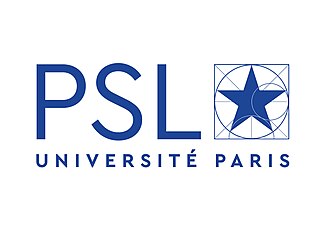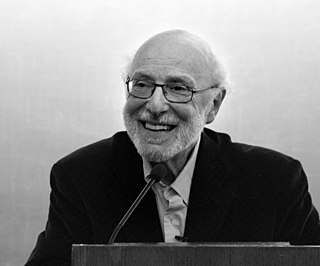
A quasiperiodic crystal, or quasicrystal, is a structure that is ordered but not periodic. A quasicrystalline pattern can continuously fill all available space, but it lacks translational symmetry. While crystals, according to the classical crystallographic restriction theorem, can possess only two-, three-, four-, and six-fold rotational symmetries, the Bragg diffraction pattern of quasicrystals shows sharp peaks with other symmetry orders—for instance, five-fold.

The French National Centre for Scientific Research is the French state research organisation and is the largest fundamental science agency in Europe.

A grande école is a specialized top-level educational institution in France and some other previous French colonies such as Morocco and Tunisia. Grandes écoles are part of an alternative educational system that operates alongside the mainstream French public university system, and take the shape of institutes dedicated to teaching, research and professional training in either pure natural and social sciences, or applied sciences such as engineering, architecture, business administration, or public policy and administration.

Jean Baptiste Perrin was a French physicist who, in his studies of the Brownian motion of minute particles suspended in liquids, verified Albert Einstein's explanation of this phenomenon and thereby confirmed the atomic nature of matter. For this achievement he was honoured with the Nobel Prize in Physics in 1926.

Dan Shechtman is the Philip Tobias Professor of Materials Science at the Technion – Israel Institute of Technology, an Associate of the US Department of Energy's Ames National Laboratory, and Professor of Materials Science at Iowa State University. On April 8, 1982, while on sabbatical at the U.S. National Bureau of Standards in Washington, D.C., Shechtman discovered the icosahedral phase, which opened the new field of quasiperiodic crystals.

Georges Friedel was a French mineralogist and crystallographer.
ParisTech is a cluster that brings together 7 renowned grandes écoles based in Paris, France. It covers the whole spectrum of science, technology and management and has more than 12.000 students.
French university associations known as "pôles de recherche et d'enseignement supérieur" were a form of higher-level organization for universities and other institutions established by French law in effect from 2007 to 2013. The 2013 Law on Higher Education and Research (France) discontinued the PRES; these have been largely replaced by the new Communities of Universities and Institutions. The list below indicates the status of those institutions designated as PRES or related associations before the 2013 law took effect. See the list of public universities in France for the current status of these institutions.
Ludwik Leibler, born in 1952 is a Polish-born French physicist. He is Professor of École supérieure de physique et de chimie industrielles de la ville de Paris and member of the French Academy of Sciences and National Academy of Engineering.

Paris Sciences et Lettres University is a public research university and Grand établissement based in Paris, France. It was established in 2010 and formally created as a university in 2019. It is a collegiate university with 11 constituent schools, with the oldest founded in 1530. PSL is located in central Paris, with its main sites in the Latin Quarter, at the Montagne Sainte-Geneviève campus, at the Jourdan campus, at Porte Dauphine, and at Carré Richelieu.
Peter Kramer is a German physicist.

Alan Lindsay Mackay FRS is a British crystallographer, born in Wolverhampton.

Paris-Saclay is a research-intensive and business cluster currently under construction in the south of Paris, France. It encompasses research facilities, two French major universities with higher education institutions and also research centers of private companies. In 2013, the Technology Review put Paris-Saclay in the top 8 world research clusters. In 2014, it comprised almost 15% of French scientific research capacity.
Antoine Georges is a French physicist. He is a professor at the Collège de France in Paris and the director of the Center for Computational Quantum Physics at the Flatiron Institute, New York. In 2023, he was elected to the National Academy of Sciences.

Paris-Saclay University is a combined technological research institute and public research university in Orsay, France. Paris-Saclay was established in 2019 after the merger of four technical grandes écoles, as well as several technological institutes, engineering schools, and research facilities; giving it fifteen constituent colleges with over 48,000 students combined.

Maurice Kleman was a French physicist involved in experimental and theoretical studies of the physics of defects; he has covered various fields of research, from condensed matter to heliophysics. As an author, he has been collected by libraries worldwide.

Philippe Sautet is a French chemist. He was elected to the French Academy of sciences on 30 November 2010. He was a research director at the CNRS and works in the chemistry laboratory of the École normale supérieure de Lyon where he devoted a large part of his scientific activity to molecular modelling. Now he is a professor at the University of California - Los Angeles.

The Polytechnic Institute of Paris is a public technological university located in Palaiseau, France. It consists of six engineering grandes écoles: École polytechnique, ENSTA Paris, ENSAE Paris, École des ponts ParisTech, Télécom Paris and Télécom SudParis.
Christian Alfred Elie Janot was a French physicist and materials scientist known for his work on materials characterization using Mössbauer spectroscopy and his physical metallurgy studies of quasicrystals and noncrystalline materials using neutron scattering techniques.
Marianne Quiquandon is a French metallurgist for the French National Centre for Scientific Research (CNRS), and a member of the structural metallurgy team in the Institut de Recherche de Chimie Paris (IRCP), a joint research institute of CNRS and Chimie ParisTech. Her research involves the study of quasicrystals in aluminum alloys and the crystallographic properties of generic twisted bilayers, with her husband Denis Gratias.













